

Benzi and Michal Kahana Trip to Mazeikiai in 2003 - click here for English
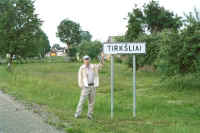
Benzi stand by the sign to the village of "TIRKSILAI"
Here stood Kalman Rachmel's tobacco shop -
LAISVES GATVE # 42 (at his
time, the house number was 40). The rear side of # 42 LAISVES GATVE The modern house that replaced the former police
station/prison on the corner of LAISVES GATVE # 42 and JABLONSKIO GATVE The house that replaced Blumeh Aronowitz's house on
LAISVES GATVE, next to the building which is today # 40. The small structure next to # 40 LAISVES GATVE A view from LAISVES GATVE looking towards the railway
station
The original Zarnikowitz building on LAISVES GATVE The Bank on LAISVES GATVE, dating to the 1930s Old wooden houses which had belonged to Jewish families,
near the railway station. Jewish Pupils 1930 Two original wooden houses on #3 VYTAUTAS street A new house, on # 5 VYTAUTAS Street, which replaced the
former house of Eliyahu-Faivel and Rashe ITING The old Jewish cemetery of Mazeikiai, and site of the mass
murder in August 1941 Graves at the Jewish cemetery, Mazeikiai The memorial to the Holocaust victims in Mazeikiai The site of the mass killing at Mazeikiai View of the Old Jewish Cemetery at Vekshne (VIEKSNIAI) Michal with Algimantus at the Old Jewish cemetery in
Vekshne (VIEKSNIAI) Hand-drawn map of the centre of Mazheik
|
 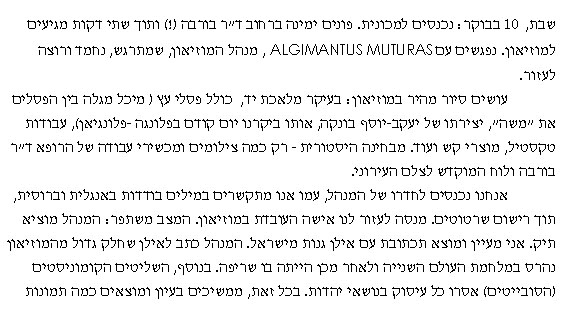 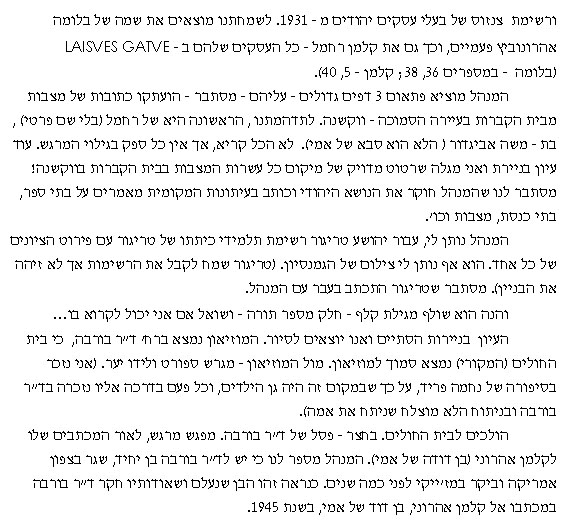 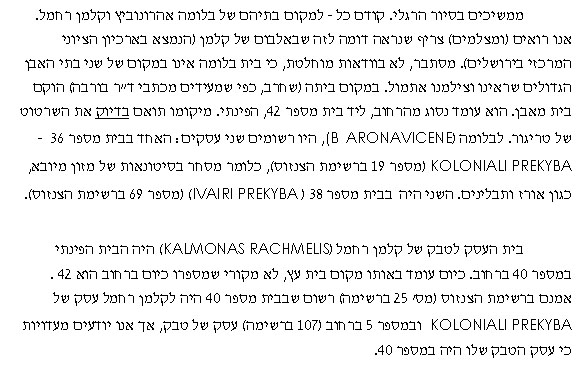 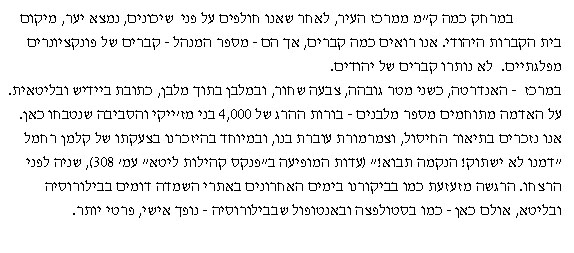 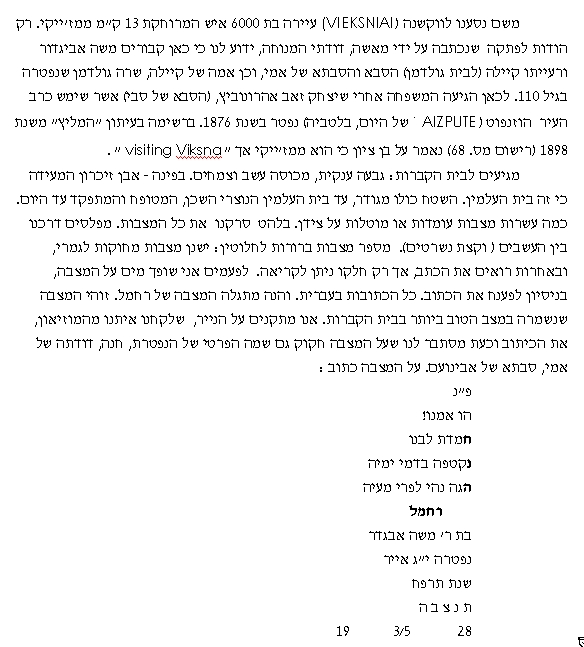 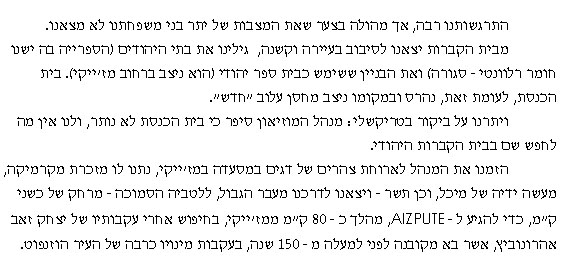 VISIT
BY MICHAL AND BENZI KAHANA TO MAZEIKIAI, LITHUANIA, JUNE
20-21, 2003 (translated
from Hebrew by Harry Arie Shamir , Plymouth Mass. Styled and edited by
Leorah Kroyanker, Jerusalem January
2004) Six
kilometers before Mazeikiai we stop by a sign:
“Tirksliai”. Here
had lived (in December 1887), according to a listing in the All Lithuania
Revision List Database the Aronowitz family: Keyla, daughter of Ziskind
[Goldman] and her five children, including my grandfather Ben-Zion (then
16 years old), before moving to Mazeikiai a few years later. (information
received with thanks from Dr. Arnold Davidson, Florida)
Of course we remember that in the Pshershkniai estate near
Tirskliai, the Nazis had imprisoned the children and women of Mazeikiai
and environs up to August 5, 1941, and on August 9, 1941all were murdered
near Mazeikiai). Finally
we arrive in Mazeikiai. According
to the town Tax and Voters List from December 20, 1892, here had lived
Keyla Aronowitz, my maternal great- grandmother, along with two other
family members. (On a
subsequent Tax and Voters List, from September 23, 1904, it is noted that
she is “well to do”, and has 3 members in her family).
(information
received with thanks from Dr. Arnold Davidson, Florida)
Although we reached Mazeikiai late in the evening, there is
still day-light; at this time of year night falls only at 11 pm. On the
outskirts of town (of 46,000) are modern “Communist” style houses,
totally unremarkable. We
drive to the town center, still without
a street-map, and reach its main street, Laisves Gatve where
we notice a “Hotel” sign,
hanging beside a large and
rather decrepit-looking building.
A nagging thought creeps in :" a ruin like this a
hotel??" but we decide to continue driving on the main street, and shortly come upon the
T-Market building, and next to it see the new Viesbutis Hotel.
We enter, gesticulate with the concierge, and after some
negotiations receive a beautiful room, large and modern, for only $34
(double occupancy). Quickly
we prepare to explore the town, aided by a drawing which Joshua Trigor, a
former town-resident now living in New York,
had prepared for us; (Trigor is currently writing reminiscences
about his youth in Mazeikiai). We also have with us notes from other
former residents of Mazeikiai, now in Israel, and also some dated
photographs. After
a short walk we identify the railway station, which is the set point for
our bearings. The station
looks deserted. We seek
Blumeh Aronowitz’s house, and the store that had belonged to Kalman
Rachmel. We see two new stone buildings that we think were built in place
of Blumeh’s house, but the next day it turns out that our
identifications were wrong. We go to sleep, anticipating the morrow’s
discoveries. Saturday,
[June 21] 10 am: we get into
the car and make a right-turn onto Dr. Burba Street, reaching the town
museum in about two minutes. There we meet Mr. Algimantus Muturas, the
Museum Director. He is very
pleased to meet us, friendly and anxious, eager to help. We
take a quick tour of the Museum that displays local handcrafts – made of
textile, straw, and also some wood statuettes. (Michal discovers among the statuettes a “Moses”, the work
of Jacob-Joseph Bunke, whom we had visited just a day before in
Plonge-Plongian). There are also some historical photographs, medical
instruments that had belonged to the physician Dr. Burba, and a board
displaying the work of the town’s photographer. We
enter the Director’s room. Communication is difficult - a few words in
English and Russian, and some drawings and sketchs to try and explain… A
woman who works in the museum is also trying to assist. Soon, the
situation improves: the
Director extracts a file, and looking over it I find correspondence with
Ilan Ganot of Israel. The
director had written to Ilan that a large part of the Museum was destroyed
during World War II; subsequently, there was a fire.
Moreover, the Soviet regime had forbidden any Jewish-related
activity. Nevertheless, we
continue examining the file and in it find some photos and a census list
of Jewish merchants from 1931. To our delight Blumeh Aronowitz's name appears on it twice,
as well as that of Kalman Rachmel – and indeed all of their enterprises
were in Laisves Gatve (Blume, at numbers 36 and 38;
Kalman, at 5 and 40). Suddenly
the Director shows us three large sheets, with rubbings of tombstone
inscriptions from the Viekshniai (Veckshna-in Yiddish-the adjacent town)
cemetery. To our amazement,
the very first rubbing is of a Rachmel (lacking a first name), daughter of
Moshe Avigdor (my maternal great- grandfather!).
Not everything on the rubbing is legible, but there is no doubting
the exciting find. Another
perusal of the paperwork and I discover an accurate drawing of the
locations of all the dozens of gravestones in Viekshniai. Apparently, the
Director is researching Jewish topics and writes articles for the local
newspaper about the schools, the Synagogues, the gravestones, etc. The
Director gives me a list of pupils from Joshua Trigor’s class (to pass
on to Trigor) with details of the grades each pupil received. He also
gives me a photo of the local gymnasium [High School].
(Trigor was delighted to receive these items though he didn't
recognize the building; apparently, Trigor and the Museum Director had had
an exchange of letters ). Then he shows me pieces of parchment – part of
a Torah scroll – and asks whether I can read it … When
we finish looking at the various documents, we set out to tour the town.
The Museum is on Dr. Burba Street, so named because the original hospital
was located nearby. Across from the Museum is
the sports grounds, and nearby, a forest (I recall that Ne’hama Fried
told me that there used to be a kindergarten there and that every time she
went there she would remember the unsuccessful surgery Dr. Burba had
performed on her mother). We
walk to the hospital. In the
garden we are excited to see a statue of Dr. Burba – who is
"familiar" to us in light of his letters to Kalman Aharoni (my
mother's cousin). The
Director tells us that Dr. Burba's only son, now living in North America,
had visited Mazeikiai a few years ago.
Probably this is the same son who had disappeared during the war,
and whose fate Dr. Burba had sought in his letter to Kalman Aharoni, in
1945. We
continue with our walking tour. First, we go to see the location of Blumeh
Aronowitz' and Kalman Rachmel's houses.
We see (and photograph) a wooden structure similar to the one which
appears in Kalman’s album (now given to the Central Zionist Archives in
Jerusalem). It turns out that
Blumeh’s house is not where we had seen the two large stone houses
yesterday, and which we had photographed.
In place of her house (which was destroyed, per Dr. Burba’s
letters) a stone building had been erected.
The new building is standing somewhat recessed from the street,
adjacent to building #42, which is the corner building.
Its location is indeed precisely as in Trigor’s drawing.
Blumeh
(B. Aronavicene) had two registered enterprises: one as Koloniali Prekyba
- a wholesaler of imported foodstuffs, such as rice and spices;
this was located in building
#36 on Laisves Gatve(#19 in
the Census List). The second
enterprise - Ivairi Prekyba - was in the building #38 on the same street (#69 in the Census List). Kalman
Rachmel's (Kalmonas Rachmelis) tobacco shop had been in the corner house
#40 on Laisves Gatve. Today instead there is a wooden structure ( not
original) bearing the number 42. Indeed,
in the list (#25 on the Census List) it is written that in house #40 was
Kalman Rachmel's "Koloniali Prekyba " and at #5 on the same
street (#107 on the Census List), was the tobacco shop; however, we know
from witnesses that the tobacconery had been at #40. Across
Jablonskio Gatve, the street perpendicular to Laisves Gatve, and right
across from Rachmel’s house, stands a modern building. It is located on
the lot where the former police station cum prison used to be, and which,
according to Trigor – had belonged to Blumeh (or to Kalman Rachmel) and
had been leased to the municipality. Hence, this whole section of the main
street of Mazeikiai had belonged to family members. To
complete the picture: Kalman
Rachmel's second business establishment was, as said, located on Laisves
Gatve #5. That, to our great astonishment is the exact location of the
abandoned hotel that we had seen the previous evening, upon entering the
town. Continuing
with our tour we see where other buildings of significance were:
the former cinema, which used to be at the end of February 16th
Street (the street which leads from the train station to Laisves Gatve)
has been pulled down. Instead is a modern building housing the Post
Office. From it one can
see the train station which still looks the way it was. The rest of the
town, as seen in the old photos, is no more.
The Synagogue is gone, and in its stead is an empty lot.
The Gymnasium (High School ) building, where Trigor had gone to
school is no more; it was
replaced by a Sports hall and a modern High School. The only house still
standing is the one that used to belong to the Zarkinowitz family: it is a
large and unattractive three story multifamily building. We
leave Laisves Gatve and continue the tour in the side streets, such as
Respublika Street, where Jews used to live.
The original buildings are still extant, and now are nicely
painted. At the corner of
Jablonskio Gatve, Mr. Muturas, the
Museum Director, points to a
wooden house, painted green
which he says used to be the Jewish school. We
reach the train station and enter the building that is in a sorry state.
It is quite deserted, except for a father and his young son. We
take a picture of the posted train schedule: there are three lines -
including the Mazeikiai – Vilna one. On this very line, which had
existed in 1900, my grandfather Ben Zion Aronowitz had traveled prior to
his marriage with Sara Lifschitz from Antopol, before they moved to live
in Vilna. We
ask the director to show us the old Iting family house – this is the
home of Ilan Ganot's father. Their
house had been on #5 Vytautas Gatve, (not far from the intersection
between the train tracks and Laisves Gatve). The house does not exist any
more, and instead there is a new building.
However, there are still two very old wooden houses at #3, and we
photograph these. When Moshe
Iting, Ilan's father saw the pictures he was very moved – they aroused
profound memories. Some
kilometers from the center of Mazeikiai, after passing several large
housing neighborhoods, is a forest, the locale of the Jewish cemetery.
We see some graves, but according to the Director, these are the
graves of party functionaries and no Jewish graves are left. In
the center is a memorial, two meters high, made of black marble, and on it, inscribed in white are inscriptions
in Yiddish and Lithuanian. On
the ground are marked several rectangles – the mass graves of 4000 Jews
from Mazeikiai and neighboring villages who were slaughtered here. We remember the description of the mass murder, and we
shudder recalling how Kalman Rachmel had cried out, seconds before being
shot dead: “Our blood will not remain silent!
Vengeance will come!” (this
testimony is recorded (in Hebrew) in "Lithuanian Jewry", Volume
IV (the Holocaust), page 308). We
are overwhelmed with emotions – having visited over the past few days
similar murder–sites in in Belarus and in Lithuania; here, however, as
in Stolpze and in Antopol (in Belarus) – there is a more personal
connection. From
the Mazeikiai cemetery we drive some 13 kilometers to Viekshniai, a town
of 6000 people. Only because of a handwritten note by Masha, my late aunt,
that we even know that that Moshe Avigdor and his wife Keyle (born
Goldman), my maternal great-grandparents were both buried here, as was
Sara Goldman, Keyle’s mother (and my great-great-grandmother), who had
passed away at the age of 110. The
Aronowitz family arrived in Viekshniai (Veckshna in Yiddish) after Itzik
(Isaac) Zeev Aronowitz, (my maternal great-great-grandfather) who had been
the Rabbi of the town of Aizpute (Hasenpoth) in Latvia, had died in 1876.
Reference to Vieksniai was also found in a listing in HaMelitz
newspaper of 1898 (listed #68), where it was written that Ben Zion
Aronowitz from Mazeikiai was “visiting Vieksniai”. We
arrive at the Viekshniai cemetery: it
is a huge hill, overgrown with grass and vegetation. In one corner is a commemorative stone that this is a
cemetery. The entire cemetery
area is fenced in, right up to the well-maintained Christian cemetery
nearby, which is still in use. Several
tombstones are still erect, others have fallen, and are on the ground. We
begin looking at the stones with adrenalin flowing in our blood...
We make our way among the bushes (and get a bit scratched) and find
that some inscriptions on the stones are still very clear, some have
become completely illegible and others are partly legible.
Sometimes I need to pour water over a stone, in order to attempt
reading an inscription. All the inscriptions are in Hebrew. Finally we find the Rachmel tombstone, which happens to be
the best preserved one in the cemetery.
We correct the text of the inscription that we had as a rubbing on
paper, from the Mazheikiai Museum. It
turns out that on the stone itself the name of the deceased is quite clear
– it is Hanna Rachmel, my mother's aunt, and Avino'oam Rachmel's
grandmother. The inscription (in translation) reads: Oh
our Mother! Dearest
to our hearts Plucked
in the prime of life A
voice we will be to her womb’s fruit Rachmel
Daughter
of R’ Moshe Avigdor Year
"Tarpah" [5688] 19
3/5
28 (*
the initial word in lines 2,3,4 forms the Hebrew acrostic of the name
Hanna). We
are very excited about this find, but also saddened that we have not found
any of the other tombstones of family members who had been buried in
Viekshniai. From
the cemetery we continue to tour the town of Viekshniai.
We see former Jewish houses (but the local library, in which there
is relevant material, is closed), and the former Jewish School building
(it is perpendicular to Mazeikiai Street).
The Synagogue of Viekshniai was destroyed, and in its place was
built a new but now rather decrepit –looking warehouse. We
did not go to visit Tirksliai - the
Museum Director, our guide, told us that nothing was left there of the
Synagogue, and we had no links to search for in the Jewish cemetery. After
our tour we return to Mazeikiai and invite the Museum Director for lunch
at a local Fish Restaurant. We give him, as
a souvenir of our visit, a
piece of ceramic ware, hand crafted by Michal, as well as a tip. Then we
set out on our way, to cross the border to nearby Latvia – and to visit Aizpute, some 80 km from Mazeikiai.
There we are searching for traces of Itzik (Isaac) Zeev Aronowitz,
my maternal great-great grandfather, who had come from Kovna over 150
years ago, to serve as the Rabbi of the town of Hasenpoth (Aizpute) |
This page is hosted at no cost to the public by JewishGen, Inc., a non-profit corporation. If you feel there is a benefit to you in accessing this site, your JewishGen-erosity is appreciated. Kindly link to : https://www.jewishgen.org/JewishGen-erosity/
| Compiled by Raymond Ravinsky Updated: August, 2019 Copyright © 2009 Raymond Ravinsky |
Link to : KehilaLinks Directory https://kehilalinks.jewishgen.org/ |
Link to : Jewish
Gen Home Page |